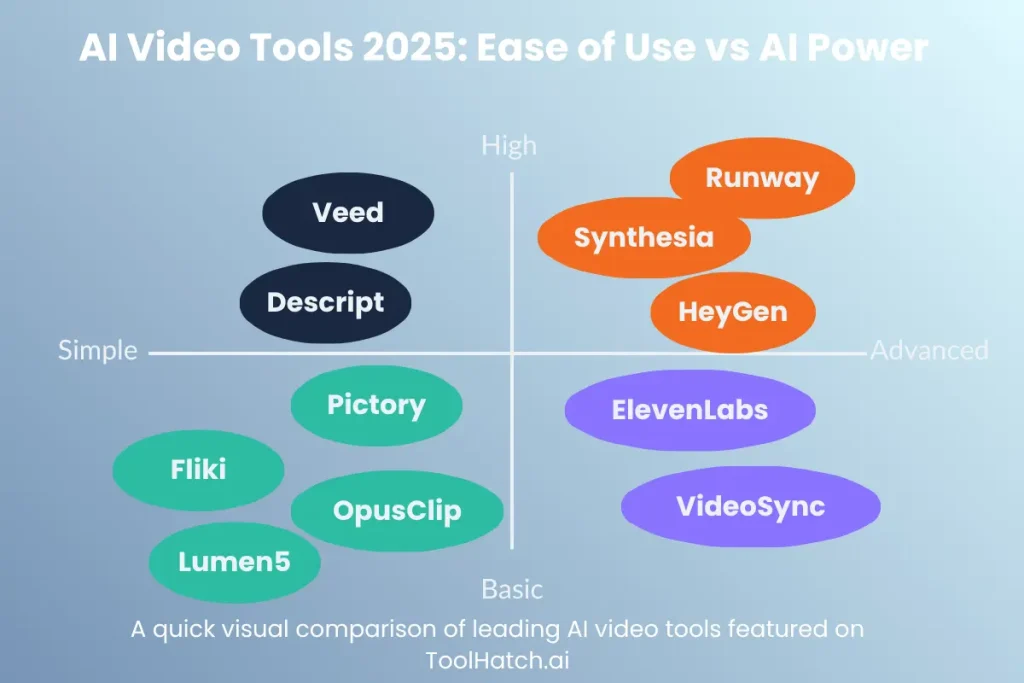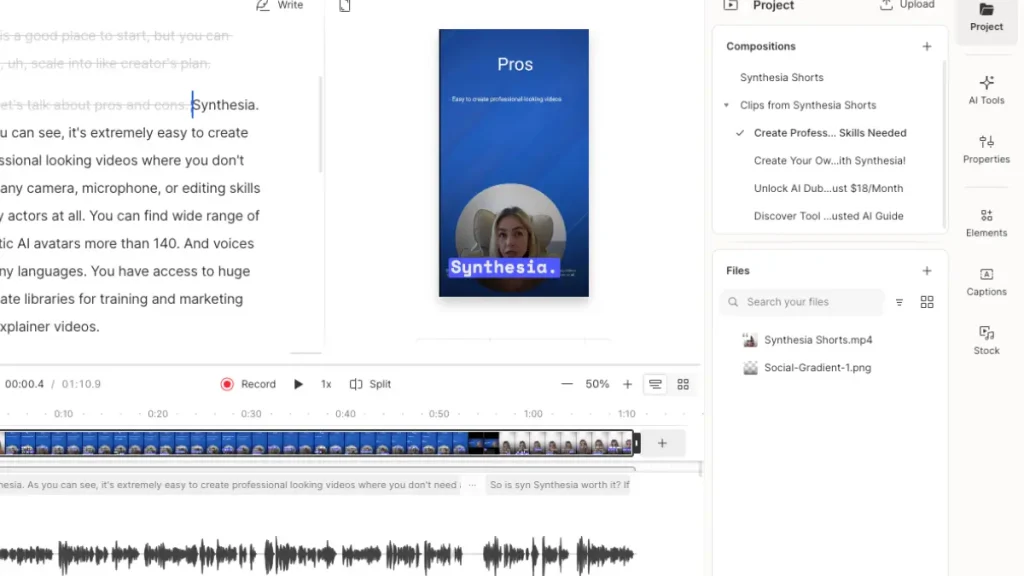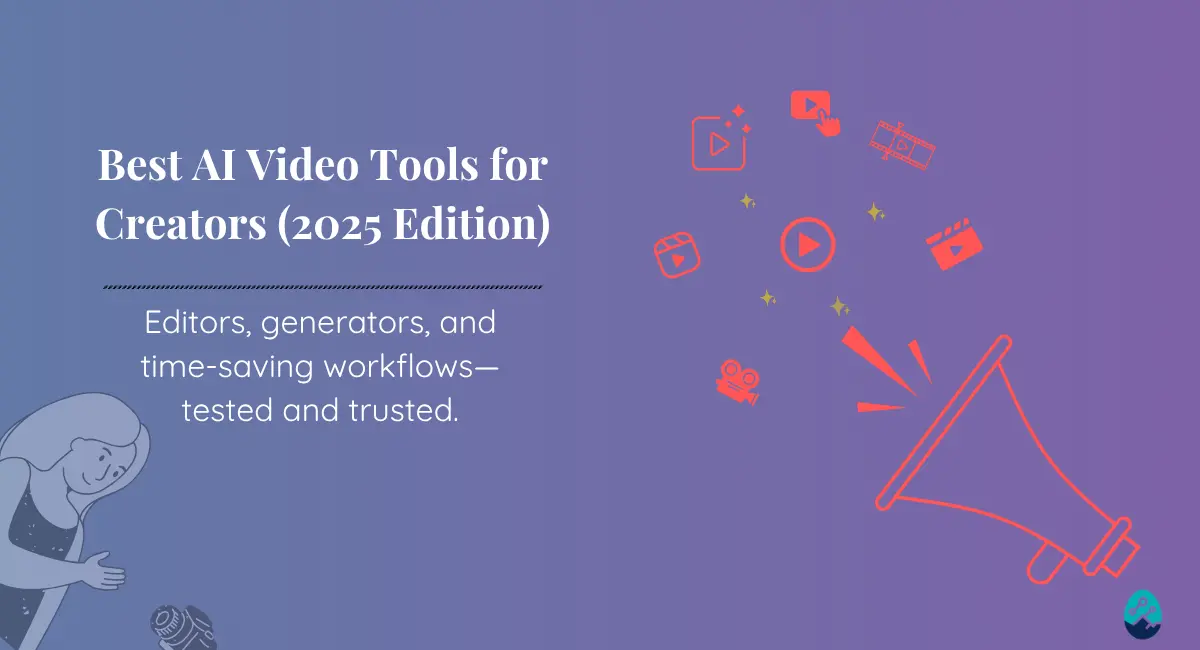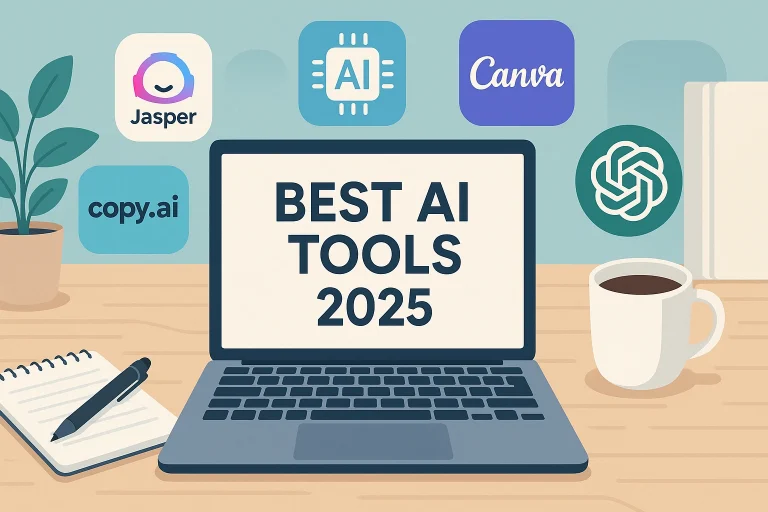Best AI Video Tools for Creators (2025 Edition)
Why AI Video Tools Are a Game-Changer for Creators
Video creation has always been one of the most time-consuming parts of content production. Between trimming footage, syncing captions, and repurposing long videos into short clips, even the most passionate creators can feel buried under the workload. That’s why 2025 has become the year of AI video tools.
These tools aren’t just about saving time — they’re changing how creators think about storytelling. With AI, you can generate full videos from text, translate and dub your voice in multiple languages, or automate repetitive editing tasks that once took hours. The result is a workflow that lets you focus on ideas, not timelines.
Whether you’re a YouTuber, social media manager, educator, or small business owner, AI video tools are making professional-quality content accessible to everyone.
What to Look for in the Best AI Video Tools
Choosing the right tool starts with understanding how it fits your goals. Here’s what separates great AI video platforms from the rest.
Ease of Use and Templates
A good AI video tool should help you start creating within minutes. Platforms like Veed.io and Synthesia are built around simplicity, offering ready-made templates that make your workflow faster without sacrificing quality.
AI Subtitles, Dubbing, and Translations
If you reach global audiences, automatic captioning and dubbing can be a game changer. Descript and Veed.io both provide accurate transcription and translation features that help your videos stay accessible across languages and platforms.
Editing Speed and Automation
AI should do the heavy lifting. Features like automatic silence removal, AI B-roll generation, or voice clean-up dramatically speed up editing. Tools such as Descript and HeyGen excel here, giving creators polished results with minimal effort.
Integrations with YouTube, TikTok, and Workflow Tools
Modern creators need tools that connect seamlessly. Veed.io integrates directly with YouTube and TikTok publishing workflows, while Synthesia works well for companies that distribute training content through LMS systems. The smoother the integration, the more time you save on uploads and reformatting.
Now that you know what matters most in choosing an AI video platform, here’s how today’s top tools compare on those very factors.

The 10 Best AI Video Tools for Creators in 2025
This list highlights a mix of tools that ToolHatch has already reviewed in depth and others that are widely recognized by creators for their standout performance. The goal is to give you a complete view of what’s leading the AI video landscape in 2025 — and which platforms are next in line for our full reviews.
1. Synthesia – Best for AI Avatars and Multilingual Videos

Synthesia remains the industry standard for AI avatar videos. It allows you to create full videos from scripts using lifelike digital presenters who speak in over 130 languages. The interface feels familiar — much like working in PowerPoint — and the results are professional enough for marketing, e-learning, or internal communication.
If you’re deciding between Synthesia and other video creation platforms, you can read our detailed Descript vs Synthesia comparison for a closer look at how they differ.
2. Veed.io – Best Browser-Based AI Editor

Veed.io brings the entire editing process into your browser. There’s no software to install, and you can instantly create captions, translations, and branded templates. Its AI features include silence removal, subtitle automation, and even AI-powered voice translation.
For teams or freelancers, Veed.io’s shared workspace makes collaboration easy. You can review, comment, and export projects without endless file exchanges, making it an ideal choice for agencies or content teams managing multiple clients.
3. Descript – Best for Script-Based Editing

Descript is one of the most innovative editing tools for creators who prefer working with text. Once you upload your recording, Descript automatically transcribes it. You can then cut, rearrange, and edit video simply by modifying the transcript.
This workflow eliminates the need for complex editing timelines. Descript also includes AI dubbing, filler-word removal, and automatic captions, making it a one-stop solution for YouTubers, podcasters, and educators.
4. Pictory – Best for Turning Text into Video
Pictory converts written content into engaging, short-form videos. By entering a blog post, script, or article, you can generate visual stories complete with voiceovers and captions.
It’s particularly useful for marketers and social media managers who need to maintain a steady content pipeline without manually editing every piece. While we haven’t yet published a full ToolHatch review on Pictory, it’s frequently mentioned by creators for its ease of use and reliable automation. If you need to repurpose long-form content into social-ready clips, this platform deserves a closer look in 2025.
5. Runway – Best for Generative Video Creation
Runway pushes the creative limits of AI video. Using its Gen-2 model, you can turn text prompts or still images into full video sequences. It’s a favorite among creators who want to experiment with cinematic storytelling, visual effects, or ad campaigns without hiring a production crew.
Runway’s motion tracking, background editing, and text-to-video features make it one of the most advanced generative tools available. For artistic creators, it’s a glimpse into the future of video creation.
6. HeyGen – Best for AI Spokesperson Videos
HeyGen lets you create professional-looking spokesperson videos using avatars and cloned voices. It’s ideal for explainers, training, or brand updates that need a consistent on-screen presence.
Although it hasn’t yet been reviewed on ToolHatch, community feedback highlights its realistic lip-syncing and language options. Expect a full hands-on review soon as we expand our AI video coverage.
7. OpusClip – Best for Repurposing Long Videos
OpusClip automatically identifies the most engaging segments in your long videos and repackages them as short, shareable clips. For creators focused on YouTube Shorts, TikTok, or Instagram Reels, it’s one of the most valuable automation tools available.
The platform adds captions, highlights, and social-optimized layouts automatically. If you already use Veed.io or Descript, OpusClip fits seamlessly into your existing workflow and helps extend your video reach without extra effort. While not yet part of our official reviews, it’s one of the most talked-about repurposing tools in creator circles and will likely be added to ToolHatch’s upcoming test queue.
8. Fliki – Best for Quick Voiceover Videos
Fliki converts text into high-quality voiceover videos with a few clicks. You can use it to create product explainers, social media posts, or tutorials in record time.
Its natural-sounding AI voices are comparable in quality to ElevenLabs, but Fliki’s strength lies in simplicity. The interface is beginner-friendly, and its large media library gives you instant access to background visuals and music. It’s perfect for creators who need daily or high-volume content. Though a ToolHatch review is still upcoming, early users praise its user-friendly design and growing feature set. It’s an approachable choice for creators testing AI video for the first time.
9. Lumen5 – Best for Marketing Teams
Lumen5 is tailored for businesses and agencies that create branded videos regularly. It transforms blog posts, press releases, or articles into short, engaging clips optimized for social sharing.
You can customize fonts, layouts, and brand colors easily, ensuring every video stays on message. For content teams managing multiple campaigns, Lumen5 is a time-saver that keeps production consistent and visually cohesive. We haven’t reviewed it yet on ToolHatch, but its longevity and proven performance make it a safe bet for teams that produce social content regularly.
10. ElevenLabs + VideoSync Combo – Best for AI Voice and Video Production
ElevenLabs continues to set the standard for ultra-realistic AI voices. When paired with editing tools such as Veed.io or VideoSync, it enables creators to produce fully narrated videos in multiple languages.
The workflow is simple: generate a natural-sounding narration in ElevenLabs, then sync it to visuals in your chosen editor. This combination gives you professional-quality results that sound as authentic as human speech.
AI Video Tools vs. AI Video Generators
AI video tools and AI video generators are often mentioned together, but they serve slightly different purposes.
- AI video tools are designed to automate editing, subtitles, and production tasks. Tools like Veed.io and Descript fall into this category, helping you refine and enhance your existing footage.
- AI video generators create videos entirely from prompts or scripts. Synthesia and Runway are great examples, capable of generating avatars or entire scenes without any raw footage.
Many creators use both. You might generate a video in Synthesia, then edit and brand it in Veed.io. This hybrid approach offers the best of both worlds: automation and creative control.
For comparison enthusiasts, our Jasper vs Copy.ai article demonstrates how a similar dynamic applies to writing tools — one focuses on generation, the other on editing refinement.
Which AI Video Tool Is Right for You?
For YouTubers
Pair Descript with OpusClip. You’ll have text-based editing for long-form videos and instant short-form content optimized for social platforms.
For Social Media Marketers
Veed.io, Fliki, and Lumen5 offer fast, branded video production. These platforms allow marketers to maintain consistent output without sacrificing creativity or quality.
For Educators and Trainers
Synthesia and HeyGen provide professional training and e-learning videos using avatars that can speak in multiple languages. They’re ideal for explaining complex topics without setting up a studio.
For Businesses and Internal Communications
Combine HeyGen with ElevenLabs to produce multilingual spokesperson or onboarding videos. The results look polished, save significant production time, and can easily be updated when messaging changes.
Future Trends in AI Video Creation (2025 and Beyond)
The next generation of AI video tools is moving toward intelligent automation that understands context, emotion, and tone. Expect avatars that can react in real time, smarter dubbing that matches emotional nuance, and generative video that can create scenes from simple sketches or voice prompts.
These advancements will make video production more intuitive and integrated. In the near future, creators could script, edit, voice, and publish entire videos from a single unified dashboard. That’s a major shift for creators and marketers who have spent years managing fragmented workflows.
As AI continues to evolve, the tools will increasingly serve as creative partners — suggesting edits, generating B-roll, or optimizing clips for engagement based on your previous uploads. For creators, this means a future where the technology feels invisible, and the focus stays on storytelling.

Final Thoughts
AI is not replacing creativity; it’s amplifying it. The best AI video tools of 2025 empower creators to do more — to experiment, iterate, and publish at a pace that would have been impossible just a few years ago.
Whether you’re a solo YouTuber, a marketer managing multiple campaigns, or a business producing internal communications, these tools can help you turn ideas into professional videos quickly and affordably.
Explore detailed reviews, comparisons, and editor insights on ToolHatch.ai to find the perfect platform for your workflow. Each review is written to help you understand not just what a tool does, but how it fits into real creative processes.
The future of video belongs to creators who adapt, and AI is the partner that makes that possible.
Key Takeaway:
AI video tools are now an essential part of the creative process. They enable faster production, smarter automation, and more opportunities to tell stories that resonate — all without the technical barriers of traditional editing.



